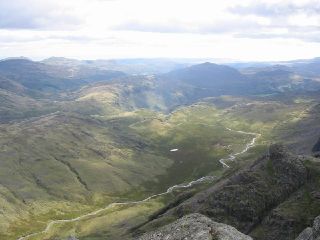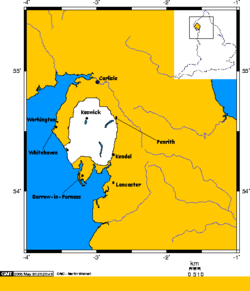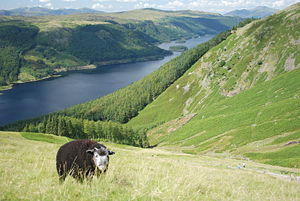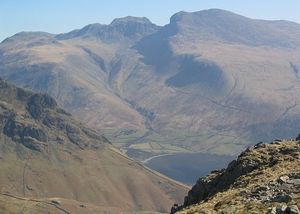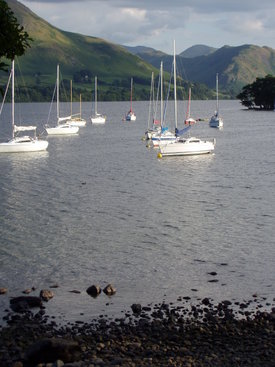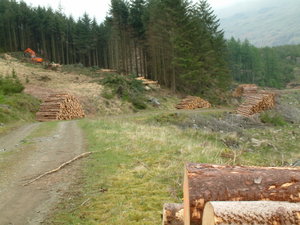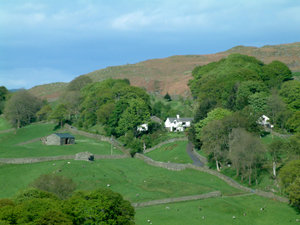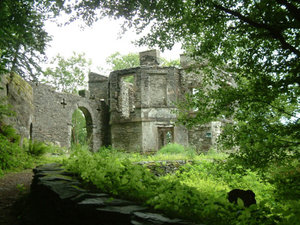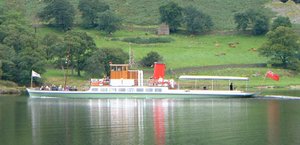Lake District
2008/9 Schools Wikipedia Selection. Related subjects: Geography of Great Britain
The Lake District, also known as The Lakes or Lakeland, is a rural area in North West England. A popular holiday destination, it is famous for its lakes and its mountains (or fells), and its associations with the early 19th century poetry and writings of William Wordsworth and the Lake Poets.
The central and most-visited part of the area is contained in the Lake District National Park—one of fourteen National parks in the United Kingdom. It lies entirely within Cumbria, and is one of England's few mountainous regions. All the land in England higher than three thousand feet above sea level lies within the National Park. The Lake District also contains Scafell Pike, the highest mountain in England.
Geography
General geography
The Lake District is about 34 miles (55 km) across. Its features are a result of periods of glaciation, the most recent of which ended some 15,000 years ago. These include the ice-carved wide U-shaped valleys, many of which are now filled with the lakes that give the park its name. The upper regions contain a number of glacial cirques, which are typically filled with tarns. The higher fells are rocky, with lower fells being open moorland, notable for its wide bracken and heather coverage. Below the tree line, native oak woodlands sit alongside nineteenth century pine plantations. Much of the land is often boggy, due to the high rainfall. The Lake District is one of the most highly populated national parks. Its total area is near 885 square miles (2,292 km²), and the Lake District was designated as a National Park in 1951.
North-west
The north-western area stands between the valleys of Borrowdale and Buttermere, with Honister Pass joining the two dales. This area comprises the Newlands Fells ( Dale Head, Robinson, Catbells) and the ridge joining them. To the north stand Grasmoor, Grisedale Pike and the hills around the valley of Coledale, and in the far north-west is Thornthwaite Forest and Lord's Seat. The fells in this area are rounded Skiddaw slate, with few tarns and relatively few rock faces.
West
The western part is the area between Buttermere and Wasdale, with Sty Head forming the apex of a large triangle. Ennerdale bisects the area, which consists of the High Stile ridge north of Ennerdale, the Loweswater Fells in the far north west, the Pillar group in the south west, and Great Gable (2,949 feet/899 metres) near Sty Head. Other tops include Seatallan, Haystacks and Kirk Fell. This area is craggy and steep, with the impressive pinnacle of Pillar Rock its showpiece. Wastwater, located in this part, is England's deepest lake. Rising up around the Western Valley of Wasdale is Scafell Pike, England's highest mountain.
Central
The central part is the lowest in terms of elevation. It takes the form of a long boot-shaped ridge running from Loughrigg Fell above Ambleside—a popular tourist destination—to Keswick, with Derwent Water on the west and Thirlmere on the east. The Langdale Pikes, with High Raise behind them, are another feature popular with walkers. The central ridge running north over High Seat is exceptionally boggy.
East
The eastern area consists of a long north-to-south ridge—the Helvellyn range, running from Clough Head to Seat Sandal with the 3,118-foot (950 m) Helvellyn at its highest point. The western slopes of these summits tend to be grassy, with rocky corries and crags on the eastern side. The Fairfield group lies to the south of the range, and forms a similar pattern with towering rock faces and hidden valleys spilling into the Patterdale valley. It culminates in the height of Red Screes overlooking the Kirkstone Pass.
Far-east
The far-eastern fells lie on the other side of Patterdale and are characterised by steep sides leading up to a huge moorland plateau, again on a north–south axis. High Street is the highest point on the ridge, overlooking the hidden valley of Mardale and Haweswater. In the south of this region are the fells overlooking Kentmere, and to the east is Shap Fell, a huge area that is more akin to the Pennines than the Lakes, consisting of high flat moorland.
Mid-west
The mid-western fells form a triangular shape, with the corners at the Irish Sea, Borrowdale and Langdale. They comprise the Wastwater Screes overlooking Wasdale, the Glaramara ridge overlooking Borrowdale, the three tops of Crinkle Crags, Bowfell and Esk Pike overlooking Langdale and Scafell Pike in the centre, at 3,209 feet (978 m) the highest ground in England. Scafell one mile (1.6 km) to the south-west is slightly lower but has a 700-foot (210 m) rock face on its north face, Scafell Crag. The valley of Eskdale penetrates this upland wilderness. These fells are the most rugged and craggy of all, and consequently going is slower amongst the tumbled granite.
South-west
The south-western fells have as their northern boundary the Hardknott and Wrynose Passes. These are particularly narrow and steep, with tight hairpin bends. The Furness Fells (invariably referred to as the Coniston Fells by walkers) stand between Coniston and the Duddon Valley, which runs NE-SW through the centre of the area. On the other side of the Duddon is Harter Fell and the long ridge leading over Whitfell to Black Combe and the sea. The south of this region consists of lower forests and knolls, with Kirkby Moor on the southern boundary. The south-western Lake District ends near the Furness peninsulas, which leads to Cumbria's second largest settlement ( Barrow-in-Furness). The Castlehead field centre is in this area.
South-east
The south-eastern area is the territory between Coniston Water and Windermere and east of Windermere. There are no high summits in this group; it is mainly low hills, knolls and bumpy terrain such as Gummer's How, Whitbarrow and Top o' Selside. The wide expanse of Grizedale Forest stands between the two lakes. Kendal and Morecambe Bay mark the edge.
25 highest peaks
The 25 highest peaks (of those given an individual chapter in the Pictorial Guides by Alfred Wainwright) are:
- Scafell Pike, 978 m (3,210 ft)
- Scafell, 965 m (3,162 ft)
- Helvellyn, 951 m (3,118 ft)
- Skiddaw, 931 m (3,054 ft)
- Great End, 910 m (2,986 ft)
- Bowfell, 902 m (2,960 ft)
- Great Gable, 899 m (2,949 ft)
- Pillar, 892 m (2,926 ft)
- Nethermost Pike, 891 m (2,923 ft)
- Catstycam, 889 m (2,917 ft)
- Esk Pike, 885 m (2,903 ft)
- Raise (Lake District), 883 m (2,896 ft)
- Fairfield, 873 m (2,863 ft)
- Blencathra, 868 m (2,847 ft)
- Skiddaw Little Man, 865 m (2,837 ft)
- White Side, 863 m (2,831 ft)
- Crinkle Crags, 859 m (2,818 ft)
- Dollywaggon Pike, 858 m (2,815 ft)
- Great Dodd, 857 m (2807 ft)
- Grasmoor, 852 m (2,795 ft)
- Stybarrow Dodd, 843 m (2,772 ft)
- St Sunday Crag, 841 m (2,759 ft)
- Scoat Fell, 841 m (2,759 ft)
- Crag Hill, 839 m (2,753 ft)
- High Street, 828 m (2,717 ft)
A more extensive list of fells can be found on the list of fells in the Lake District.
Lakes
Only one lake in the National Park has the word "Lake" in its name, namely Bassenthwaite Lake. All the others such as Windermere, Coniston Water, Ullswater and Buttermere use other forms, with mere being particularly common. The major lakes and reservoirs in the National Park are given below.
- Bassenthwaite Lake
- Brotherswater
- Buttermere
- Coniston Water
- Crummock Water
- Derwent Water
- Devoke Water
- Elterwater
- Ennerdale Water
- Esthwaite Water
- Grasmere
- Haweswater Reservoir
- Loweswater
- Rydal Water
- Thirlmere
- Ullswater
- Wast Water
- Windermere
More lakes, tarns and reservoirs can be found on the list of lakes in the Lake District.
Geology
The Lake District's geology is complex but well-studied. Its oldest rocks are the Skiddaw Slate series and the Borrowdale Volcanic series dating back to the Ordovician, some 500 million years ago. The Skiddaw Slates are found in the northern part of the park and were probably deposited in shallow seas; their thickness is unknown. The Borrowdale Volcanic rocks are more extensive and form the Lakes' highest peaks, being resistant to weathering. Later intrusions have formed individual outcrops of igneous rock in both these series. The other large rock group is the Silurian Windermere Group, made of Limestone that rests upon the volcanic rocks. Many smaller series are also present.
Climate
The Lake District's location on the north west coast of England, coupled with its mountainous geography, makes it the dampest part of England. The UK Met Office reports average annual precipitation of more than 2,000 millimetres (80 in), but with very large local variation. Although the entire region receives above average rainfall, there is a wide disparity between the amount of rainfall in the western and eastern lakes. Lake District has relief rainfall. Seathwaite in Borrowdale is the wettest inhabited place in the British Isles with an average of 3,300 millimetres (130 in) of rain a year, while nearby Sprinkling Tarn is even wetter, recording over 5,000 millimetres (200 in) per year; by contrast, Keswick, at the end of Borrowdale receives 1,470 millimetres (60 in) per year, and Penrith (just outside the Lake District) only 870 millimetres (30 in). March to June tend to be the driest months, with October to January the wettest, but at low levels there is relatively little difference between months.
The Lake District is also windy, although sheltered valleys experience gales on an average of five days a year. In contrast, the coastal areas have 20 days of gales; while the fell tops may have 100 days of gales per year.
The maritime climate means that the Lake District experiences relatively moderate temperature variations through the year. Mean temperature in the valleys ranges from about 3 °C (37 °F) in January to around 15 °C (59 °F) in July. (By comparison, Moscow, at the same latitude, ranges from -10 °C to 19 °C/14°F to 66°F).
The relatively low height of most of the fells means that, while snow is expected during the winter, they can be free of snow at any time of the year. Normally, significant snow fall only occurs between November and April. On average, snow falls on Helvellyn 67 days per year. During the year, valleys typically experience 20 days with snow falling, a further 200 wet days, and 145 dry days.
Hill fog is common at any time of year, and the fells average only around 2.5 hours of sunshine per day, increasing to around 4.1 hours per day on the coastal plains.
Wildlife
The area is home to a plethora of wildlife, some of which is unique in England. It provides a home for the red squirrel and colonies of sundew and butterwort, two of the few carnivorous plants native to Britain. England's only nesting pair of Golden Eagles can be found in the Lake District. Sadly the female Golden Eagle has not been seen since 2004 although the male still remains.
The lakes of the Lake District support three rare and endangered species of fish: the vendace, which can be found only in Bassenthwaite Lake and Derwent Water, the schelly, which lives in Brothers Water, Haweswater, Red Tarn and Ullswater, and the Arctic charr, which can be found in Buttermere, Coniston Water, Crummock Water, Ennerdale Water, Haweswater, Loweswater, Thirlmere, Wast Water, and Windermere.
In recent years, some important changes have been made to fisheries byelaws covering the north-west region of England, to help protect some of the rarest fish species. The Environment Agency has introduced a new fisheries byelaw, banning the use of all freshwater fish as live bait or as dead bait in 14 of the lakes in the Lake District. Anglers who do not comply with the new byelaw could face fines of up to £2,500. The byelaw was introduced on 26 July 2002.
There are 14 lakes in the Lake District which are affected. These are: Bassenthwaite Lake, Brothers Water, Buttermere, Coniston Water, Crummock Water, Derwent Water, Ennerdale Water, Haweswater, Loweswater, Red Tarn, Thirlmere, Ullswater, Wast Water and Windermere.
The lakes and waters of the Lake District do not naturally support as many species of fish as other similar habitats in the south of the country and elsewhere in Europe. Some fish that do thrive there are particularly at risk from accidental or deliberate introduction of new species.
The introduction of non-native fish can lead to the predation of the native fish fauna or competition for food. There is also the risk of disease being introduced, which can further threaten native populations. In some cases, the introduced species can disturb the environment so much that it becomes unsuitable for particular fish. For example, a major problem has been found with ruffe. This non-native fish has now been introduced into a number of lakes in recent years. It is known that ruffe eat the eggs of vendace, which are particularly vulnerable because of their long incubation period. This means that they are susceptible to predators for up to 120 days. The eggs of other fish, for example roach, are only at risk for as little as three days.
Industry and agriculture
In Neolithic times, the Lake District was a major source of stone axes, examples of which have been found all over Britain. The primary site, on the slopes of the Langdale Pikes, is sometimes described as a "stone axe factory" of the Langdale axe industry. Some of the earliest stone circles in Britain are connected with this industry.
Since Roman times, farming, in particular of sheep, was the major industry in the region. The breed most closely associated with the area is the tough Herdwick, with Rough Fell and Swaledale sheep also common. Sheep farming remains important both for the economy of the region and for preserving the landscape which visitors want to see. Features such as dry stone walls, for example, are there as a result of sheep farming. Some land is also used for silage and dairy farming. There are extensive plantations of non-native pine trees.
The area was badly affected by the foot-and-mouth outbreak across the United Kingdom in 2001. Thousands of sheep, grazing on the fellsides across the District, were destroyed. In replacing the sheep, one problem to overcome was that many of the lost sheep were heafed, that is, they knew their part of the unfenced fell and did not stray, with this knowledge being passed between generations. With all the sheep lost at once, this knowledge has to be re-learnt and some of the fells have had discreet electric fences strung across them for a period of five years, to allow the sheep to "re-heaf".
Mining, particularly of copper, lead (often associated with quantities of silver), baryte, graphite and slate, was historically a major Lakeland industry, mainly from the 16th century to the 19th century. Coppiced woodland was used extensively to provide charcoal for smelting. Some mining still takes place today—for example slate mining continues at the Honister Mines, at the top of Honister Pass. Abandoned mine-workings can be found on fell-sides throughout the district. The locally-mined graphite led to the development of the pencil industry, especially around Keswick.
In the middle of the 19th century, half the world textile industry's bobbin supply came from the Lake District area. Over the past century, however, tourism has grown rapidly to become the area's primary source of income.
Development of tourism
Early visitors to the Lake District, who travelled for the education and pleasure of the journey, include Celia Fiennes who in 1698 undertook a journey the length of England, including riding through Kendal and over Kirkstone Pass into Patterdale. Her experiences and impressions were published in her book Great Journey to Newcastle and Cornwall:
- As I walked down at this place I was walled on both sides by those inaccessible high rocky barren hills which hang over one’s head in some places and appear very terrible; and from them springs many little currents of water from the sides and clefts which trickle down to some lower part where it runs swiftly over the stones and shelves in the way, which makes a pleasant rush and murmuring noise and like a snowball is increased by each spring trickling down on either side of those hills, and so descends into the bottoms which are a Moorish ground in which in many places the waters stand, and so form some of those Lakes as it did here.
In 1724, Daniel Defoe published the first volume of A Tour Thro' the Whole Island of Great Britain. He commented on Westmorland that it was:
- the wildest, most barren and frightful of any that I have passed over in England, or even Wales itself; the west side, which borders on Cumberland, is indeed bounded by a chain of almost unpassable mountains which, in the language of the country, are called fells.
Towards the end of the 18th century, the area was becoming more popular with travellers. This was partly a result of wars in Continental Europe, restricting the possibility of travel there. In 1778 Father Thomas West produced A Guide to the Lakes, which began the era of modern tourism.
West listed "stations"—viewpoints where tourists could enjoy the best views of the landscape, being encouraged to appreciated the formal qualities of the landscape and to apply aesthetic values. At some of these stations, buildings were erected to help this process. The remains of Claife Station (on the western shore of Windermere below Claife Heights) can be visited today.
William Wordsworth published his Guide to the Lakes in 1810, and by 1835 it had reached its fifth edition, now called A Guide through the District of the Lakes in the North of England. This book was particularly influential in popularising the region. Wordsworth's favourite valley was Dunnerdale or the Duddon Valley nestling in the south-west of the Lake District.
The railways led to another expansion in tourism. The Kendal and Windermere Railway was the first to penetrate the Lake District, reaching Kendal in 1846 and Windermere in 1847. The line to Coniston opened in 1848 (although until 1857 this was only linked to the national network with ferries between Fleetwood and Barrow-in-Furness); the line from Penrith through Keswick to Cockermouth in 1865; and the line to Lakeside at the foot of Windermere in 1869. The railways, built with traditional industry in mind, brought with them a huge increase in the number of visitors, thus contributing to the growth of the tourism industry. Railway services were supplemented by steamer boats on the major lakes of Ullswater, Windermere, Coniston Water, and Derwent Water.
The growth in tourist numbers continued into the age of the motor car, when railways began to be closed or run down. The formation of the National Park in 1951 recognised the need to protect the Lake District environment from excessive commercial or industrial exploitation, preserving that which visitors come to see, without (so far) any restriction on the movement of people into and around the district. The M6 Motorway helped bring traffic to the Lakes, passing up its eastern flank. The narrow roads present a challenge for traffic flow and, from the 1960s, certain areas have been very congested.
Whilst the roads and railways provided easier access to the area, many people were drawn to the Lakes by the publication of the Pictorial Guide to the Lakeland Fells by Alfred Wainwright. First published in the 1950s, these books provided detailed information on 214 peaks across the region, with carefully hand-drawn maps and panoramas, and also stories and asides which add to the colour of the area. They are still used by many visitors to the area as guides for walking excursions, with the ultimate goal of bagging the complete list of Wainwrights. The famous guides are being revised by Chris Jesty to reflect changes, mainly in valley access and paths.
The area has also become associated with writer Beatrix Potter. A number of tourists visit to see her family home, with particularly large numbers coming from Japan.
Tourism has now become the park's major industry, with about 14 million visitors each year, mainly from the UK's larger settlements, China, Japan, Spain, Germany and the USA. Windermere Lake Steamers are now the UK's second most popular charging tourist attraction and the local economy is dependent upon tourists. The negative impact of tourism has been seen, however. Soil erosion, caused by walking, is now a significant problem, with millions of pounds being spent to protect over-used paths. In 2006, two Tourist Information Centres in the National Park were closed.
Cultural tourism is becoming an increasingly important part of the wider tourist industry. The Lake District's links with a wealth of artists and writers and its strong history of providing summer theatre performances in the old Blue Box of Century Theatre are strong attractions for visiting tourists. The tradition of theatre is carried on by venues such as Theatre by the Lake in Keswick with its Summer Season of six plays in repertoire, Christmas and Easter productions and the many literature, film, mountaineering, jazz and creative arts festivals.
Literature and art
The Lake District is intimately associated with English literature in the 18th and 19th centuries. Thomas Gray was the first to bring the region to attention, when he wrote a journal of his Grand Tour in 1769, but it was William Wordsworth whose poems were most famous and influential. Wordsworth's poem " I Wandered Lonely as a Cloud", inspired by the sight of daffodils on the shores of Ullswater, remains one of the most famous in the English language. Out of his long life of eighty years, sixty were spent amid its lakes and mountains, first as a schoolboy at Hawkshead, and afterwards living in Grasmere (1799–1813) and Rydal Mount (1813–50). Wordsworth, Coleridge and Southey became known as the Lake Poets.
The poet and his wife lie buried in the churchyard of Grasmere and very near to them are the remains of Hartley Coleridge (son of the poet Samuel Taylor Coleridge), who himself lived for many years in Keswick, Ambleside and Grasmere. Robert Southey, the Poet Laureate and friend of Wordsworth, was a resident of Keswick for forty years (1803–43), and was buried in Crosthwaite churchyard. Samuel Taylor Coleridge lived for some time in Keswick, and also with the Wordsworths at Grasmere. From 1807 to 1815 John Wilson lived at Windermere. De Quincey spent the greater part of the years 1809 to 1828 at Grasmere, in the first cottage which Wordsworth had inhabited. Ambleside, or its environs, was also the place of residence both of Thomas Arnold, who spent there the vacations of the last ten years of his life and of Harriet Martineau, who built herself a house there in 1845. At Keswick, Mrs Lynn Linton (wife of William James Linton) was born, in 1822. Brantwood, a house beside Coniston Water, was the home of John Ruskin during the last years of his life. His assistant W. G. Collingwood the author, artist and antiquarian lived nearby, and wrote Thorstein of the Mere, set in the Norse period.
In addition to these residents or natives of the Lake District, a variety of other poets and writers made visits to the Lake District or were bound by ties of friendship with those already mentioned above. These include Percy Bysshe Shelley, Sir Walter Scott, Nathaniel Hawthorne, Arthur Hugh Clough, Henry Crabb Robinson, Thomas Carlyle, John Keats, Lord Tennyson, Matthew Arnold, Felicia Hemans, and Gerald Massey.
During the early 20th century, the children's author Beatrix Potter was in residence at Hill Top Farm, setting many of her famous Peter Rabbit books in the Lake District. Her life was made into a biopic film, starring Renée Zellweger and Ewan McGregor. Arthur Ransome lived in several areas of the Lake District, and set a number of his Swallows and Amazons books, published between 1930 and 1947, in a fictionalised Lake District setting. So did Geoffrey Trease with his five Black Banner school stories (1949–56), starting with No Boats on Bannermere.
The novelist Sir Hugh Walpole lived at "Brackenburn" on the lower slopes of Catbells overlooking Derwent Water from 1924 until his death in 1941. Whilst living at "Brackenburn" he wrote The Herries Chronicle detailing the history of a fictional Cumbrian family over two centuries. The noted author and poet Norman Nicholson came from the south-west Lakes, living and writing about Millom in the twentieth century – he was known as the last of the Lake Poets and came close to becoming the Poet Laureate.
Writer and Author Melvyn Bragg was brought up in the region and has used it as the setting for some of his work, such as his novel "A time to dance", later turned into a television drama.
Film Director Ken Russell lives in the Keswick/Borrowdale area and has used it in some films, such as Tommy and Mahler
Some students of Arthurian lore identify the Lake District with the Grail kingdom of Listeneise.
The former Keswick School of Industrial Art at Keswick was started by Canon Rawnsley, a friend of John Ruskin.
Nomenclature
A number of words and phrases are local to the Lake District and are part of the Cumbrian dialect. These include:
- fell - brought to England by Viking invaders and close to modern Norwegian "fjell" and Swedish "fjäll" meaning mountain
- tarn - a word that has been taken to mean a small lake situated in a corrie, a local phrase for any small pool of water. The word is derived from the old Norse and Norwegian word "tjærn".
- Yan Tan Tethera - the name for a system of sheep counting which was traditionally used in the Lake District. Though now rare, it is still used by some and taught in local schools.
